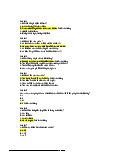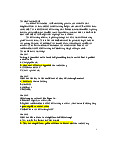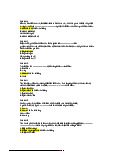

Preview text:
What in the ENGLISH Quarter 1
Study online at https://quizlet.com/_fn1y5x Five MACRO-SKILLS
Listening, Speaking, Reading, Writing, Viewing Myth
A traditional story about gods, ancestors, or heroes, told to explain
the natural world or the customs and beliefs of a society.
body of stories concerning the gods, heroes, and rituals of the Greek Mythology ancient Greeks
EX. Twelve Olympian Gods and Goddesses Graphic Organizer
a tool that helps to organize ideas and can be used to visually illustrate ideas Circle Map to brainstorm ideas Venn Diagram
to explain the DIFFERENCES and SIMILIRATIES between two concepts Flowchart
to illustrate the STEPS, sequences Tree Chart
to display the hierarchical RELATIONS of a structure in graphical form. Line Graph
uses line segments to show CHANGES that occur over time Bar Graph
uses horizontal or vertical bars to display DATA Literary Techniques
strategy/style/method of the AUTHOR to create a meaningful and
significant literary masterpiece series of events - Exposition - Rising action Plot -Climax - Falling action - Resolution Exposition Introduction Climax Peak of a story, EXCITIING Resolution Ending Theme central message Tone
- Author's attitude toward the subject
- Expressed through WORD choice Mood
- emotional atmosphere/reaction of the readers
- influenced by SETTING, DICTION, IMAGERY
MESSAGE, intention behind the work Purpose
- to inform, to persuade, to entertain, to encourage, to express, etc. Technique
literary devices/tropes used by the author to establish a CONNO- TATIVE meaning - verbal Irony - situational - dramatic Allusion
brief reference on a SIGNIFICANT PERSON, place or event use of sensory images/objects - Visual - Auditory (hearing) Imagery - Olfactory (smell) - Gustatory (taste) - Tactile (touch) Symbolism
uses OBJECTS to create a meaning Allegory
uses narrative/stories/songs/poems that present BROADER con- cepts/ideas Anaphora
REPETITION of a word or phrases 1 / 2 What in the ENGLISH Quarter 1
Study online at https://quizlet.com/_fn1y5x Juxtaposition
PLACEMENT of two or more CONTRASTING elements side by side Flashback
a sudden clear memory of a PAST event or time Foreshadowing
a HINT on what's about to happen Paradox uses of CONTRADICTORY words Example : loud silence Formal Definitions - precise and structured
- contextually professional in tone/factual - Term FORMAL: structured parts - Class/Genus
- Differentiating Characteristics Informal Definition - flexible and conversational
- casual, opinionated, creative, subjective FD and ID Difference Structure, Language, Context Definition
group of words that gives the MEANING, description and/or infor- mation about a certain TERM TAKE NOTE
Even if a definition has 3/complete parts, it's still informal if it's
opinionated, use creative words, etc. FD Structure SPECIFIC and structured format
-term, class/category, distinguishing characteristics FD Language
precise, technical, and unambiguous (only one), language FD Context
often found in academic, legal, or technical contexts where CLAR- ITY and ACCURACY are crucial ID Structure
< More relaxed and does not follow a strict format
< May involve: Explanations, Examples, Analogies ID Language
uses more EVERYDAY LANGUAGE and may include FIGURA- TIVE language or metaphor
< typically used in everyday conversation, literature, or casual writing ID Context
< Goal: make the concept UNDERSTANDABLE rather than pre- cise FD Audience
Intended for readers who require accurate information ID Audience
Intended for a broader audience, often in non-specialist settings Intensive Pronoun
- used to emphasize another noun or pronoun
- not necessary to the sentence Reflexive Pronoun
- used to refer to the subject of the sentence - necessary part of a sentence 2 / 2




